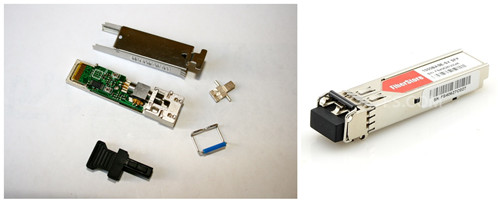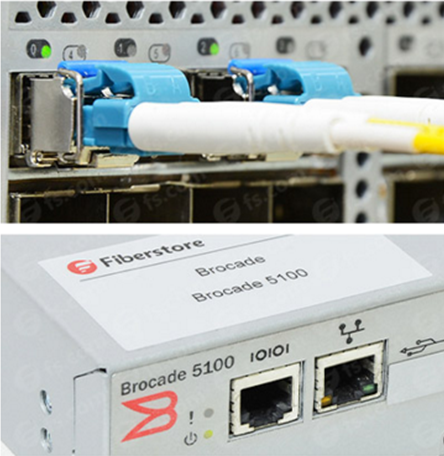SFP optical transceiver is generally regarded as the most useful technological advancements of the telecom industry. This transceiver is less than half the width of the GBICs and created under the Multi-Source Agreement (MSA). SFP transceiver is hot-swappable, which is highly beneficial to network designers. What’s more, the smaller size and high performance enable the enterprises to cost-effectively migrate to Gigabit Ethernet. There are a number of small form pluggable (SFP) optical modules and network accessories to select from. Therefore, to save your troubles, this article elaborates three basic information of SFP transceiver module to make sure you have chosen the right one.
The Origin of SFP Optical Module
SFP transceiver modules are hot-pluggable module with LC interfaces. SFP can be simply treated as the upgrade version of GBIC. SFP module volume ratio reduced by half, the same panel can be configured in more than double of ports. Other features of SFP Module are generally the same as the GBIC. Devices like NETGEAR AGM731F SFP (see in Figure 1) Modules tend to be smaller and are only about half the size of GBIC optics. AGM731F is 1000BASE-SX SFP that operates over the inexpensive 850nm wavelength for a distance of 550m. The SFP module sends speeds that range from 100 Mbps to about 5 Gbps. Their transmission length begins at about 500 meters and goes up to 120 kilometers.

Types of SFP Optical Transceiver
SFP transceivers are capable of providing an exceptional amount of variation to consumers. Typically, optical transceivers come in either multimode fiber or single-mode fiber type. And according to different standard, the SFP module is commonly offered in four different categories, which include SX, LX, ZX, and DWDM. Each of these different types interface with copper cables and this permits the motherboard to communicate with the unshielded twisted pair (UTP). CWDM cables and single-mode bi-directional fiber optic cables will transmit data both upstream and downstream.

SFP optical transceivers are available in wavelength of 850nm/1310nm/1550nm/1490nm/1530nm/1610nm. Of which the 850nm wavelength is SFP multimode with a limited transmission distance within 2km. While the 1310/1550nm is SFP single-mode, and the transmission distance is longer than 2km. The price of the 850nm/1310nm/1550nm SFP transceiver module is relatively cheaper than the other three. Take E1MG-LX-OM as an example, it is Brocade 1000BASE-LX SFP operating at a wavelength of 1310nm. E1MG-LX-OM can support a link length of 10km. The above image presents a Brocade E1MG-LX-OM with a single-mode fiber inserting into a Brocade Switch.
Features of the SFP Optical Transceiver
- MSA Standard-based Design Assures Compatibility
An SFP transceiver is capable of transferring rates up to 4.25 Gpbs. The MSA standard-based design assures compatibility. XFP form factor is similar to the SFP type. The functionality increases about three times at 10 Gpbs with this type of transceiver type.
- Digital Diagnostics Monitoring (DDM) Enhances Management Capability
Digital optical monitoring (DOM) enables a real time link to be established between the switch and the SFP transceiver. Thus network designers have the ability to monitor real-time parameters such as optical inputs and output power, laser bias, and supply voltage, etc. Additional, the DOM functionality enables the capability to implement digital alarms and warming.
- Hot-swappable Design Facilitates Network Maintenance
SFP transceivers are hot-swappable and have the capability to allow design modification until the final stages of manufacturing. This makes it easier to accommodate different connector interfaces.
Last but not least, an SFP cage may be required for proper operation of the device. It’s usually mounted to the PCB board and will accept the transceiver. It eliminates extra manufacturing steps and reduces costs. SFP transceivers also have a higher optical reliability and will permit higher soldering temperatures. SFP transceivers are recommended by fiber optic component providers to ensure proper data transmission.
Conclusion
SFP transceivers are expected to perform at data speeds of up to 5 Gbps, and possibly higher. Because SFP modules can be easily interchanged, the fiber optic networks can be upgraded and maintained more conveniently than has been the case with traditional soldered-in modules. Fiberstore, as a representative of the rising telecommunication supplier, manufactures a full range of optical transceivers. All of our products are fully tested and compatible with the original brand. The E1MG-LX-OM and AGM731F mentioned above are also offered at Fiberstore.
评论
发表评论